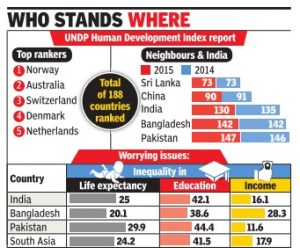According to the UN Development Programme’s Human Development for Everyone’ Report 2016, released on March 21, 2017 in Stockholm, India has been ranked at 131 out of 188 countries in the 2016 Human Development Index (HDI).
- The HDI of India was 0.624 putting it in the medium HDI category. It was placed at third spot among the SAARC nation with Sri Lanka (73) and Maldives (105) taking the first and second spots respectively and coming under high HDI category with HDI of 0.766 and 0.701 respectively.
Top 3 Countries
| Rank | Country | HDI |
| 1 | Norway | 0.949 |
| 2 | Australia | 0.939 |
| 3 | Switzerland | 0.939 |
About the HDI Report
The index was based on three dimensions:
- Life expectancy at birth,
- Mean years of schooling and expected years of schooling,
- Gross national income per capita
India’s Performance
The report stated that the HDI value of India has increased by 46 percent (from 0.428 to 0.624) between 1990 and 2015 while its gross national income per capita increased by about 223.4 percent.
- Though India’s rank lowered by one spot from last year at 130, the increase in HDI was credited to the success of national development programmes like Skill India, Digital India, Make in India and Beti Bachao Beti Padhao.
- The report said that on the perception of feeling safe in India, 69% answered “yes”, while on freedom of choice, 72% female responders answered they were “satisfied” as compared to 78% for male.
- India’s score for overall life satisfaction was 4.3 on a scale of 1-10, according to the report.
- On perceptions about government, 69% said they had trust in the national government for the 2014-15 period while 74% said they had confidence in the judicial system.
- India was placed behind countries like Gabon (109), Egypt (111), Indonesia (113), South Africa (119) and Iraq (121), China (90).
- The report lists a total of 188 countries among which Bhutan was placed at 132, Bangladesh 139, Nepal 144 and Pakistan is at 147.
- The improvement in India’s HDI value was second among BRICS countries with China recording the highest improvement of 48 percent.
- The GDI takes into account the disparity between the HDI of men and women-the higher the disparity, the lower the GDI.
- India’s GDI is 0.819, compared to the developing country average of 0.913.
Global Performance
When considering the overall performance, the report said that the average human development improved significantly since 1990 but still the progress is uneven, with systemic discrimination against women, indigenous peoples and ethnic minorities.
- It said that even today one in three people worldwide continue to live at a low level of human development.
- The HDI report also showed that almost 1.5 billion people in developing countries live in multi-dimensional poverty. Of this, 54%, or 800 million people, are in South Asia while 34% are in Sub-Saharan Africa.
Gender Disparity
When considering the South Asian countries, the report said that the South Asia’s Gender Development Index (GDI) is the lowest.
- Women and girls are systematically excluded by economic, political, social and cultural barriers.
- The report also points to “dangerous practices,” such as female genital mutilation and forced marriage, which continue to hamper the development of women and their inclusion in society.
- The report calls for far greater attention to empowering the most marginalised in society, and recognises the importance of giving them greater voice in decision-making processes.
About the Human Development Index
The Human Development Index devised and launched in 1990 is a ranking of countries based on the developments made with a peace-centric model of progress.
- The index ranks countries into four tiers of human development on the basis of indicators like life expectancy, education and per capita income.
- A higher lifespan, higher level of education and higher GDP per capita results in a country scoring higher HDI.





